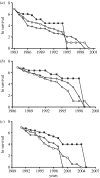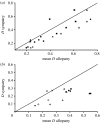Fission and fusion of Darwin's finches populations
- PMID: 18508750
- PMCID: PMC2606742
- DOI: 10.1098/rstb.2008.0051
Fission and fusion of Darwin's finches populations
Abstract
This study addresses the causes and evolutionary consequences of introgressive hybridization in the sympatric species of Darwin's ground finches (Geospiza) on the small island of Daphne Major in the Galápagos archipelago. Hybridization occurs rarely (less than 2% of breeding pairs) but persistently across years, usually as a result of imprinting on the song of another species. Hybrids survive well under some ecological conditions, but not others. Hybrids mate according to song type. The resulting introgression increases phenotypic and genetic variation in the backcrossed populations. Effects of introgression on beak shape are determined by the underlying developmental genetic pathways. Introgressive hybridization has been widespread throughout the archipelago in the recent past, and may have been a persistent feature throughout the early history of the radiation, episodically affecting both the speed and direction of evolution. We discuss how fission through selection and fusion through introgression in contemporary Darwin's finch populations may be a reflection of processes occurring in other young radiations. We propose that introgression has the largest effect on the evolution of interbreeding species after they have diverged in morphology, but before the point is reached when genetic incompatibilities incur a severe fitness cost.
Figures








Similar articles
-
Synergism of natural selection and introgression in the origin of a new species.Am Nat. 2014 May;183(5):671-81. doi: 10.1086/675496. Epub 2014 Mar 12. Am Nat. 2014. PMID: 24739199
-
Hybridization in the recent past.Am Nat. 2005 Jul;166(1):56-67. doi: 10.1086/430331. Epub 2005 Apr 19. Am Nat. 2005. PMID: 15937789
-
Hybridization increases population variation during adaptive radiation.Proc Natl Acad Sci U S A. 2019 Nov 12;116(46):23216-23224. doi: 10.1073/pnas.1913534116. Epub 2019 Oct 28. Proc Natl Acad Sci U S A. 2019. PMID: 31659024 Free PMC article.
-
Divergence and gene flow among Darwin's finches: A genome-wide view of adaptive radiation driven by interspecies allele sharing.Bioessays. 2015 Sep;37(9):968-74. doi: 10.1002/bies.201500047. Epub 2015 Jul 22. Bioessays. 2015. PMID: 26200327 Free PMC article. Review.
-
Every inch a finch: a commentary on Grant (1993) 'Hybridization of Darwin's finches on Isla Daphne Major, Galapagos'.Philos Trans R Soc Lond B Biol Sci. 2015 Apr 19;370(1666):20140287. doi: 10.1098/rstb.2014.0287. Philos Trans R Soc Lond B Biol Sci. 2015. PMID: 25750230 Free PMC article. Review.
Cited by
-
The causes and evolutionary consequences of mixed singing in two hybridizing songbird species (Luscinia spp.).PLoS One. 2013;8(4):e60172. doi: 10.1371/journal.pone.0060172. Epub 2013 Apr 5. PLoS One. 2013. PMID: 23577089 Free PMC article.
-
Genomic signatures of hybridization between Ixodes ricinus and Ixodes persulcatus in natural populations.Ecol Evol. 2024 May 20;14(5):e11415. doi: 10.1002/ece3.11415. eCollection 2024 May. Ecol Evol. 2024. PMID: 38770117 Free PMC article.
-
Development and evolution of character displacement.Ann N Y Acad Sci. 2012 May;1256(1):89-107. doi: 10.1111/j.1749-6632.2011.06381.x. Epub 2012 Jan 18. Ann N Y Acad Sci. 2012. PMID: 22257002 Free PMC article. Review.
-
Behavioural response to songs between genetically diverged allopatric populations of Darwin's small tree finch in the Galápagos.J Evol Biol. 2021 May;34(5):816-829. doi: 10.1111/jeb.13783. Epub 2021 Mar 25. J Evol Biol. 2021. PMID: 33714212 Free PMC article.
-
The ecological stage changes benefits of mate choice and drives preference divergence.Philos Trans R Soc Lond B Biol Sci. 2020 Aug 31;375(1806):20190546. doi: 10.1098/rstb.2019.0546. Epub 2020 Jul 13. Philos Trans R Soc Lond B Biol Sci. 2020. PMID: 32654644 Free PMC article.
References
-
- Abzhanov A, Protas M, Grant P.R, Grant B.R, Tabin C.J. Bmp4 and morphological variation of beaks in Darwin's finches. Science. 2004;305:1462–1465. doi:10.1126/science.1098095 - DOI - PubMed
-
- Abzhanov A, Kuo W.P, Hartmann C, Grant B.R, Grant P.R, Tabin C.J. The calmodulin pathway and evolution of elongated beak morphology in Darwin's finches. Nature. 2006;442:563–567. doi:10.1038/nature04843 - DOI - PubMed
-
- Anderson E. Hybridization of the habitat. Evolution. 1948;2:1–9. doi:10.2307/2405610 - DOI
-
- Arnold M.L. Oxford University Press; Oxford, UK: 1997. Natural hybridization and evolution.
-
- Arnold M.L. Oxford University Press; Oxford, UK: 2006. Evolution through genetic exchange.
Publication types
MeSH terms
LinkOut - more resources
Full Text Sources
Miscellaneous

